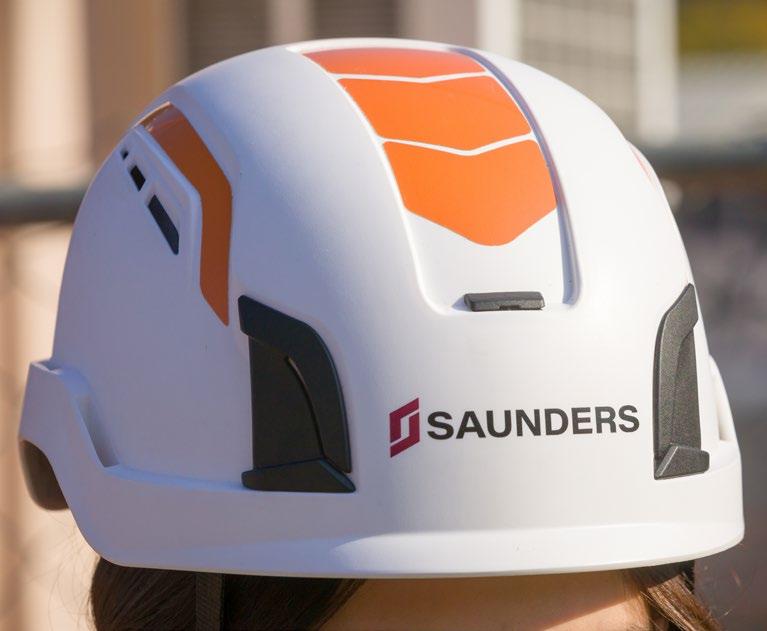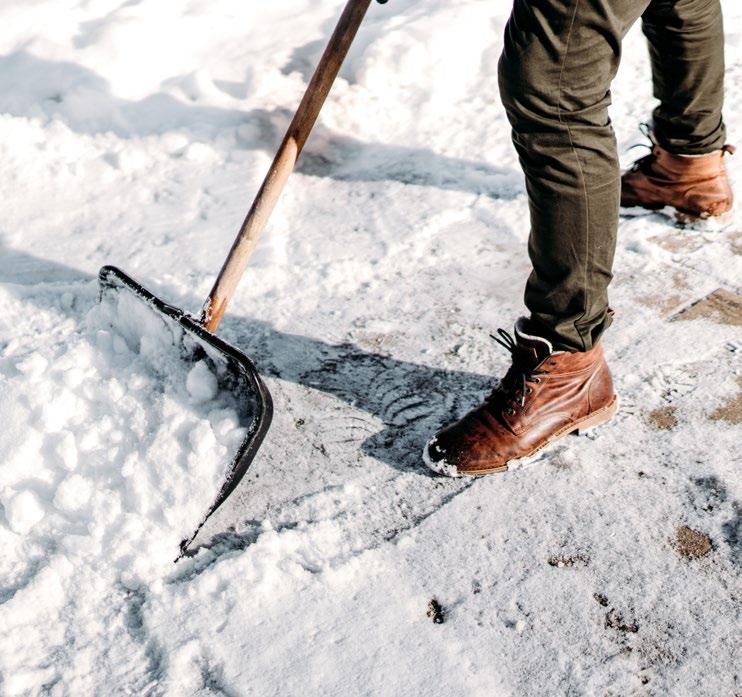

SAFETY + QUALITY MATTERS
Resources
Safety Manual
For more information on safety processes and procedures, crisis management, and online training visit the Safety page in the Playbook: https://saundersinc. sharepoint.com/playbook/ SitePages/Safety.aspx
Quality Resources
For quality control and closeout resources, visit the Quality Control page in the Playbook: https:// saundersinc.sharepoint.com/ playbook/SitePages/QualityControl.aspx
See Something, Say Something.
If you know of, or suspect any violations of our company’s values, you can anonymously report any conerns or get more information by contacting the Ethics Point hotline.
Online: saunders.ethicspoint.com Phone: 833-214-9370
November 2025
Tips, stories, and reminders to help us build better.
New Helmet Requirements Starting 2026


View the Type 2 Helmet Notice Here.
Construction safety helmets have gained widespread adoption in recent years, offering significantly improved protection compared to traditional hard hats used for over six decades. Saunders proactively transitioned to safety helmets in 2021 to enhance worker protection. It’s now time for our trade partners to do the same and provide the highest level of safety for their teams.
Projects starting in 2026 will require all trade partners to wear the new Type 2 helmet style shown above. All trade partners were notified and the contract language was updated to reflect this new requirement.
Building Enclosure Cold Weather Considerations
Cold weather construction requires careful planning and control to ensure enclosure performance, material adhesion, and long-term durability. During winter months, when ambient temperatures regularly fall below manufacturer-recommended limits, additional measures must be taken to maintain quality.
1. General Requirements
All building enclosure work—including air/weather barriers, sealants, adhesives, coatings, insulation, and claddings —shall comply with the manufacturer’s cold-weather installation requirements. The contractor is responsible for maintaining substrate and ambient temperatures within the acceptable range during application and curing. Work shall not proceed when:
» Ambient or substrate temperatures fall below the manufacturer’s published minimums.
» Surfaces contain frost, snow, or ice.
» Relative humidity or dew point conditions risk condensation on substrates.
2. Application Temperature Requirements
Common temperature thresholds for enclosure materials are outlined here. Always verify current data with manufacturer’s technical datasheet.
Material Type
Fluid-applied air/vapor barriers
Sheet membranes (self-adhered)
Sealants and caulking
Insulation adhesives & spray foam
Coatings & primers
Exterior sheathing
40°F and rising
Substrate must be dry; extended cure time below 50°F.
25-40°F depending on product Use primer approved for cold weather.
40°F
40-50°F
45-50°F
32°F and rising
3. Temporary Heating and Environmental Control
When ambient conditions fall below specified limits:
Warm materials before application; ensure joint faces are dry.
Foam yields and adhesion decrease in cold conditions.
Maintain temperature through cure period.
Avoid installation when materials are frozen or wet.
» Enclose the Work Area: Use temporary enclosures, tarps, or weather barriers to shield work zones from wind and moisture.
» Provide Supplemental Heat: Use indirect-fired heaters to maintain consistent air and substrate temperatures. Direct-fired heaters may introduce excess moisture or contaminants and should be avoided unless approved.
» Temperature Monitoring: Install thermometers or data loggers inside enclosures to document conditions during installation and curing.
» Ventilation: Provide adequate airflow to prevent condensation buildup within the temporary enclosure.
» Material Conditioning: Store sealants, adhesives, and membranes in a heated area (above 50°F) for at least 24 hours prior to use.
Building Enclosure Cold Weather Considerations (continued)
4. Quality Assurance
» Inspect substrates prior to application for frost, condensation, and contamination.
» Verify recorded temperatures (ambient and substrate) meet product requirements at time of installation.
» Confirm temporary heating setup maintains consistent conditions during and after application.
» Document curing times, temperatures, and any deviations from standard procedures.
» Ensure coordination between trades (e.g., masonry, framing, waterproofing) to prevent premature exposure or damage.
5. Summary
Maintaining building enclosure quality in cold weather depends on controlling temperature, moisture, and timing. All materials must be installed under conditions that allow for proper adhesion and curing. When in doubt, delay installation until environmental conditions can be adequately managed through enclosure and heating.
Examples:



Tented and heated scaffold area to apply air/weather barrier and EIFS assembly during winter.
Please reach out to the Quality Department with questions or if you need assistance on your jobsite.
Tented and heated exterior wall to install air/weather barrier during winter.
Tented and heated scaffold area to start masonry during winter.
Temporary Heating SAFETY
As colder weather approaches, it’s important to review key safety practices for using temporary heating equipment on the jobsite to keep crews warm while maintaining a safe work environment.
» Store propane cylinders outdoors if not in use.
» Keep combustibles, like visqueen plastic, away from temporary heaters.
» Contact our primary vendor, C.H.I Companies, for well-maintained and adequate heating solutions for your project.
» Have an individual wear a carbon monoxied (CO) detector during temporary heating operations.
Prepare for Winter Weather
Winter weather is approaching! Preventing slips and falls is important on all jobsites. Some key things to ask yourself as you prepare for the winter months:
» Do I have traction on my boots that I will be wearing on snowy days?
» Is there a snow removal plan in place for my jobsite or office?
» Is the chin strap on my helmet buckled in case I slip, fall and strike my head?
» Who do I report slippery conditions to onsite, or how do I fix the slip hazard to prevent others from falling?
SIF Incident
Recently, a forklift tipped over at one of our project sites. There were no life altering outcomes, but a few key takeaways are important to review to prevent future incidents:
» Operating any equipment on slopes presents a hazard of tipping or rolling.
» Employees new to project sites should always attend an orientation. This includes all temporary laborers.
» We each have the authority to stop work and review the tasks if you notice a potential safety issue.
» A refresher training class will be required for all forklift operators.
» All approved site drive areas for equipment should be easily identifiable by berms, ropes and flagging.
It’s important to exercise extreme caution when disconnecting and reconnecting gas for temporary heaters. View the training videos to ensure you know the proper steps to take.
English: Disconnecting & Reconnecting Gas for Temporary Heat
Spanish: Desconectar y volver a conectar una manguera de gas de manera segura

View the full SIF incident details at the video links below.
English: SIF: Forklift Tip Over
Spanish: Informe SIF: vuelco de un forklift elevador
For assistance with your Schoox account, contact Shani Luper at s.luper@saundersinc.com.
